CHCAGE001: Applying Communication to Build Trusting Relationships
VerifiedAdded on 2023/06/18
|6
|1147
|143
Report
AI Summary
This report discusses the application of communication strategies to build trusting relationships with clients in an aged care setting. It emphasizes the importance of establishing rapport through active listening, maintaining privacy, and using the client's name. Non-verbal cues such as paying attention to physical signs, focusing on tone of voice, maintaining eye contact, and using appropriate body language and gestures are also highlighted. The report provides examples of open-ended questions to encourage detailed responses from clients and underscores the significance of a positive attitude and respecting individual differences to foster a safe and expressive environment. The strategies aim to improve client confidence, reduce stress, and promote overall well-being in the aged care service. Desklib offers similar solved assignments and past papers for students.
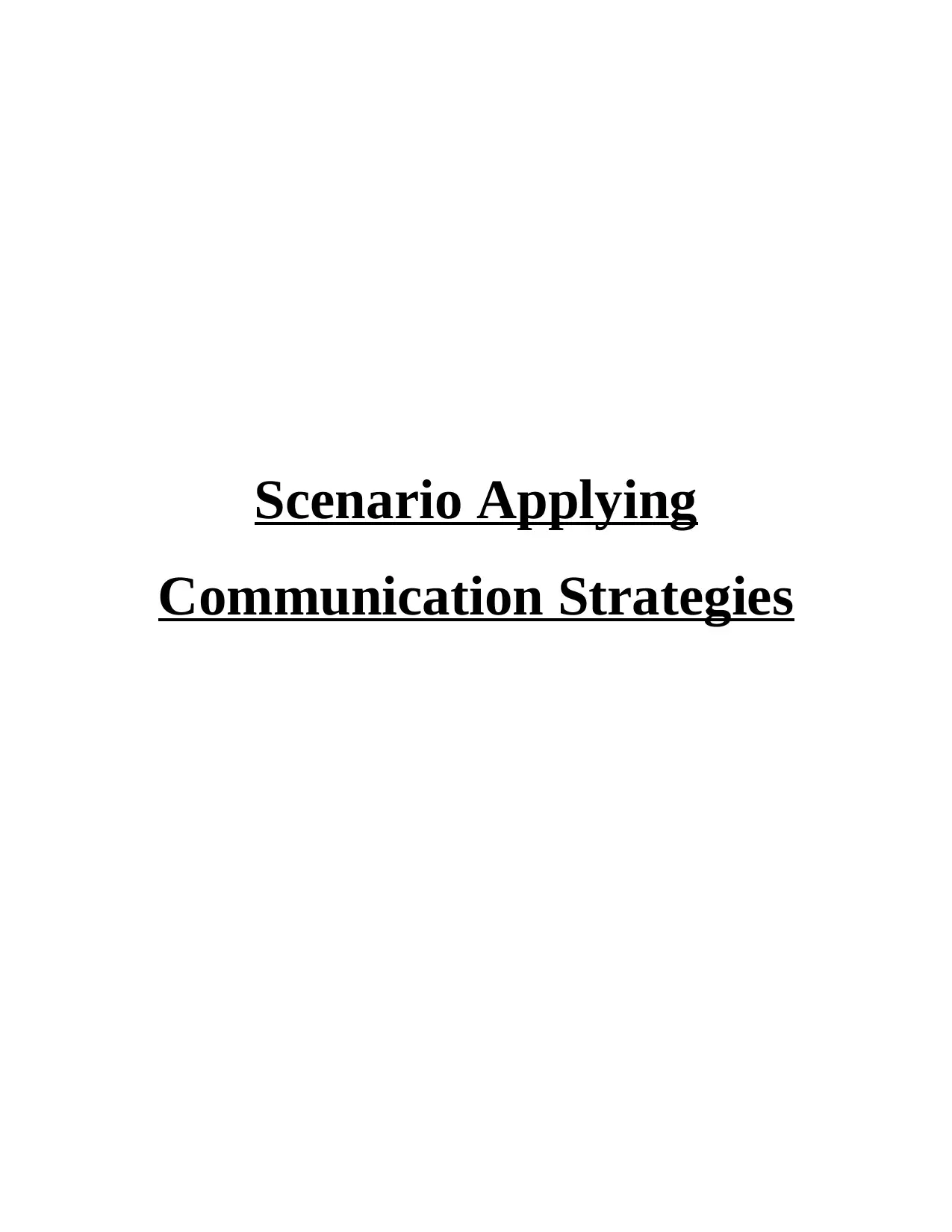
Scenario Applying
Communication Strategies
Communication Strategies
Paraphrase This Document
Need a fresh take? Get an instant paraphrase of this document with our AI Paraphraser
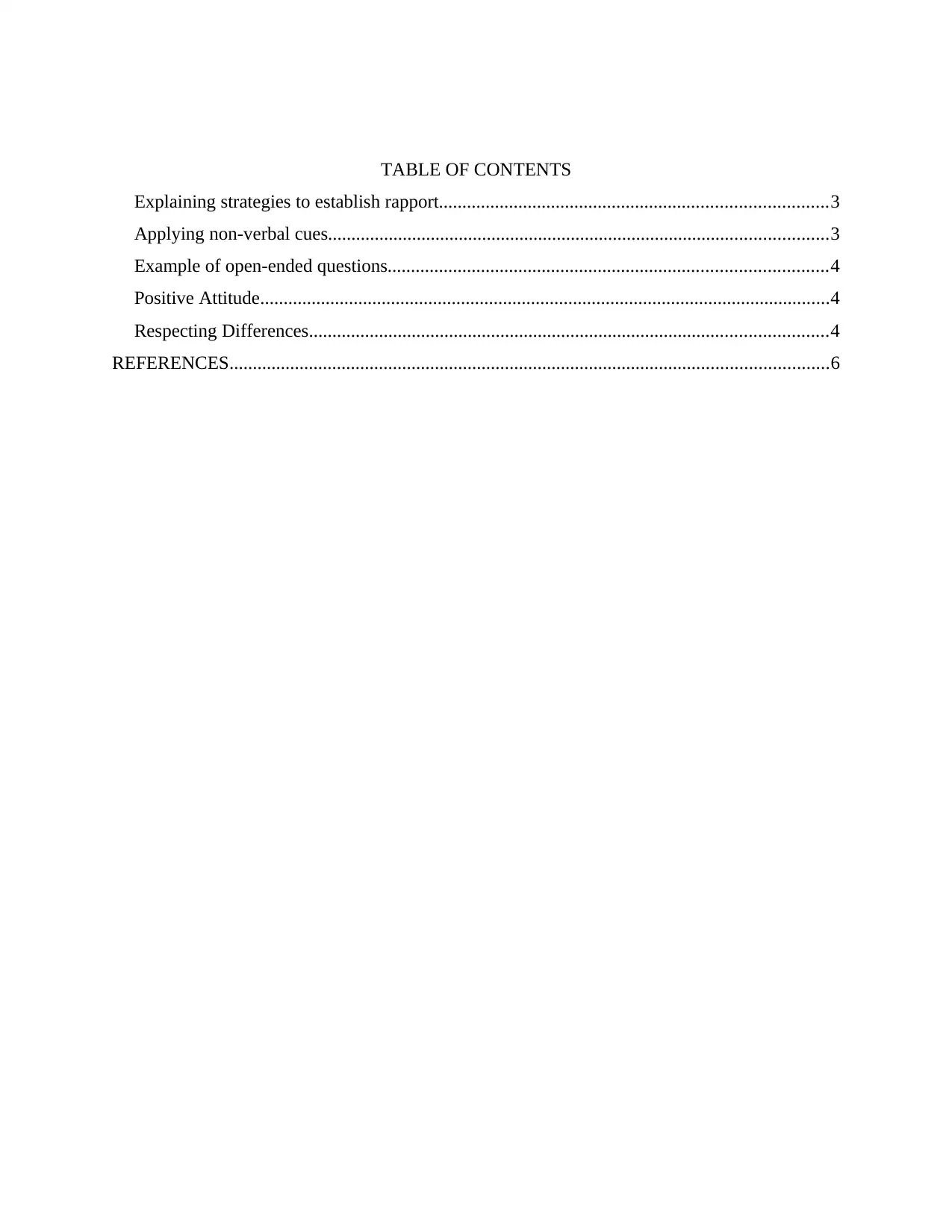
TABLE OF CONTENTS
Explaining strategies to establish rapport...................................................................................3
Applying non-verbal cues...........................................................................................................3
Example of open-ended questions..............................................................................................4
Positive Attitude..........................................................................................................................4
Respecting Differences...............................................................................................................4
REFERENCES................................................................................................................................6
Explaining strategies to establish rapport...................................................................................3
Applying non-verbal cues...........................................................................................................3
Example of open-ended questions..............................................................................................4
Positive Attitude..........................................................................................................................4
Respecting Differences...............................................................................................................4
REFERENCES................................................................................................................................6
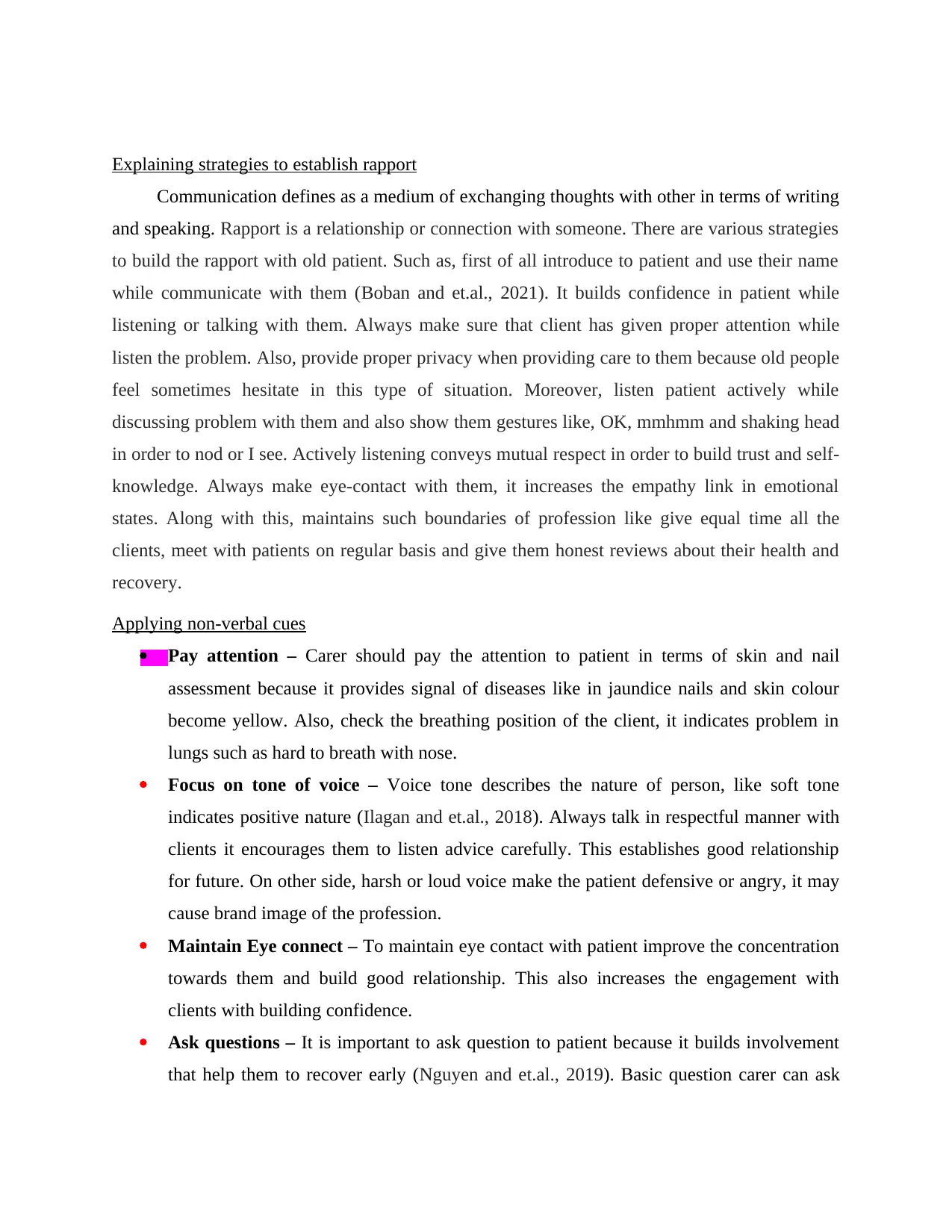
Explaining strategies to establish rapport
Communication defines as a medium of exchanging thoughts with other in terms of writing
and speaking. Rapport is a relationship or connection with someone. There are various strategies
to build the rapport with old patient. Such as, first of all introduce to patient and use their name
while communicate with them (Boban and et.al., 2021). It builds confidence in patient while
listening or talking with them. Always make sure that client has given proper attention while
listen the problem. Also, provide proper privacy when providing care to them because old people
feel sometimes hesitate in this type of situation. Moreover, listen patient actively while
discussing problem with them and also show them gestures like, OK, mmhmm and shaking head
in order to nod or I see. Actively listening conveys mutual respect in order to build trust and self-
knowledge. Always make eye-contact with them, it increases the empathy link in emotional
states. Along with this, maintains such boundaries of profession like give equal time all the
clients, meet with patients on regular basis and give them honest reviews about their health and
recovery.
Applying non-verbal cues
Pay attention – Carer should pay the attention to patient in terms of skin and nail
assessment because it provides signal of diseases like in jaundice nails and skin colour
become yellow. Also, check the breathing position of the client, it indicates problem in
lungs such as hard to breath with nose.
Focus on tone of voice – Voice tone describes the nature of person, like soft tone
indicates positive nature (Ilagan and et.al., 2018). Always talk in respectful manner with
clients it encourages them to listen advice carefully. This establishes good relationship
for future. On other side, harsh or loud voice make the patient defensive or angry, it may
cause brand image of the profession.
Maintain Eye connect – To maintain eye contact with patient improve the concentration
towards them and build good relationship. This also increases the engagement with
clients with building confidence.
Ask questions – It is important to ask question to patient because it builds involvement
that help them to recover early (Nguyen and et.al., 2019). Basic question carer can ask
Communication defines as a medium of exchanging thoughts with other in terms of writing
and speaking. Rapport is a relationship or connection with someone. There are various strategies
to build the rapport with old patient. Such as, first of all introduce to patient and use their name
while communicate with them (Boban and et.al., 2021). It builds confidence in patient while
listening or talking with them. Always make sure that client has given proper attention while
listen the problem. Also, provide proper privacy when providing care to them because old people
feel sometimes hesitate in this type of situation. Moreover, listen patient actively while
discussing problem with them and also show them gestures like, OK, mmhmm and shaking head
in order to nod or I see. Actively listening conveys mutual respect in order to build trust and self-
knowledge. Always make eye-contact with them, it increases the empathy link in emotional
states. Along with this, maintains such boundaries of profession like give equal time all the
clients, meet with patients on regular basis and give them honest reviews about their health and
recovery.
Applying non-verbal cues
Pay attention – Carer should pay the attention to patient in terms of skin and nail
assessment because it provides signal of diseases like in jaundice nails and skin colour
become yellow. Also, check the breathing position of the client, it indicates problem in
lungs such as hard to breath with nose.
Focus on tone of voice – Voice tone describes the nature of person, like soft tone
indicates positive nature (Ilagan and et.al., 2018). Always talk in respectful manner with
clients it encourages them to listen advice carefully. This establishes good relationship
for future. On other side, harsh or loud voice make the patient defensive or angry, it may
cause brand image of the profession.
Maintain Eye connect – To maintain eye contact with patient improve the concentration
towards them and build good relationship. This also increases the engagement with
clients with building confidence.
Ask questions – It is important to ask question to patient because it builds involvement
that help them to recover early (Nguyen and et.al., 2019). Basic question carer can ask
⊘ This is a preview!⊘
Do you want full access?
Subscribe today to unlock all pages.

Trusted by 1+ million students worldwide
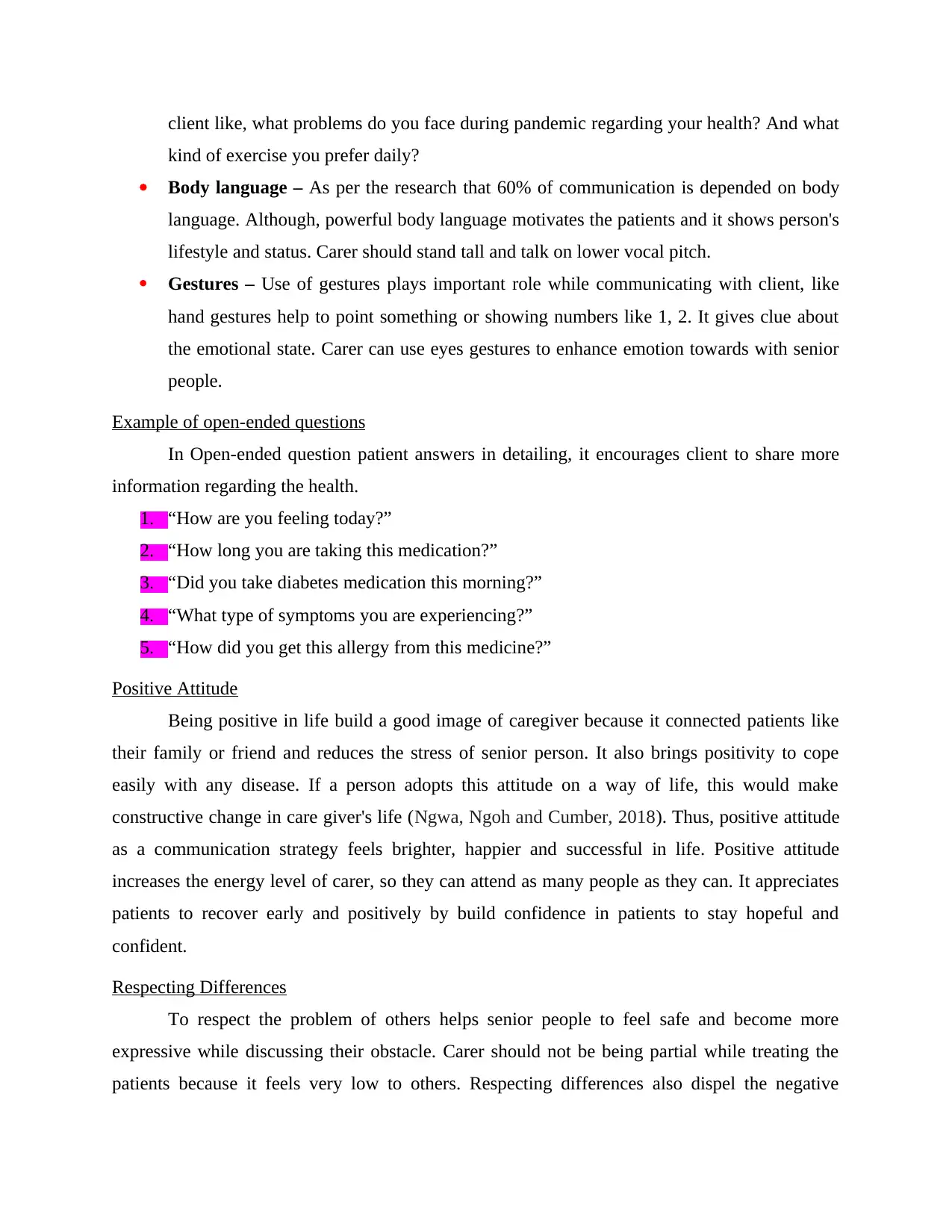
client like, what problems do you face during pandemic regarding your health? And what
kind of exercise you prefer daily?
Body language – As per the research that 60% of communication is depended on body
language. Although, powerful body language motivates the patients and it shows person's
lifestyle and status. Carer should stand tall and talk on lower vocal pitch.
Gestures – Use of gestures plays important role while communicating with client, like
hand gestures help to point something or showing numbers like 1, 2. It gives clue about
the emotional state. Carer can use eyes gestures to enhance emotion towards with senior
people.
Example of open-ended questions
In Open-ended question patient answers in detailing, it encourages client to share more
information regarding the health.
1. “How are you feeling today?”
2. “How long you are taking this medication?”
3. “Did you take diabetes medication this morning?”
4. “What type of symptoms you are experiencing?”
5. “How did you get this allergy from this medicine?”
Positive Attitude
Being positive in life build a good image of caregiver because it connected patients like
their family or friend and reduces the stress of senior person. It also brings positivity to cope
easily with any disease. If a person adopts this attitude on a way of life, this would make
constructive change in care giver's life (Ngwa, Ngoh and Cumber, 2018). Thus, positive attitude
as a communication strategy feels brighter, happier and successful in life. Positive attitude
increases the energy level of carer, so they can attend as many people as they can. It appreciates
patients to recover early and positively by build confidence in patients to stay hopeful and
confident.
Respecting Differences
To respect the problem of others helps senior people to feel safe and become more
expressive while discussing their obstacle. Carer should not be being partial while treating the
patients because it feels very low to others. Respecting differences also dispel the negative
kind of exercise you prefer daily?
Body language – As per the research that 60% of communication is depended on body
language. Although, powerful body language motivates the patients and it shows person's
lifestyle and status. Carer should stand tall and talk on lower vocal pitch.
Gestures – Use of gestures plays important role while communicating with client, like
hand gestures help to point something or showing numbers like 1, 2. It gives clue about
the emotional state. Carer can use eyes gestures to enhance emotion towards with senior
people.
Example of open-ended questions
In Open-ended question patient answers in detailing, it encourages client to share more
information regarding the health.
1. “How are you feeling today?”
2. “How long you are taking this medication?”
3. “Did you take diabetes medication this morning?”
4. “What type of symptoms you are experiencing?”
5. “How did you get this allergy from this medicine?”
Positive Attitude
Being positive in life build a good image of caregiver because it connected patients like
their family or friend and reduces the stress of senior person. It also brings positivity to cope
easily with any disease. If a person adopts this attitude on a way of life, this would make
constructive change in care giver's life (Ngwa, Ngoh and Cumber, 2018). Thus, positive attitude
as a communication strategy feels brighter, happier and successful in life. Positive attitude
increases the energy level of carer, so they can attend as many people as they can. It appreciates
patients to recover early and positively by build confidence in patients to stay hopeful and
confident.
Respecting Differences
To respect the problem of others helps senior people to feel safe and become more
expressive while discussing their obstacle. Carer should not be being partial while treating the
patients because it feels very low to others. Respecting differences also dispel the negative
Paraphrase This Document
Need a fresh take? Get an instant paraphrase of this document with our AI Paraphraser
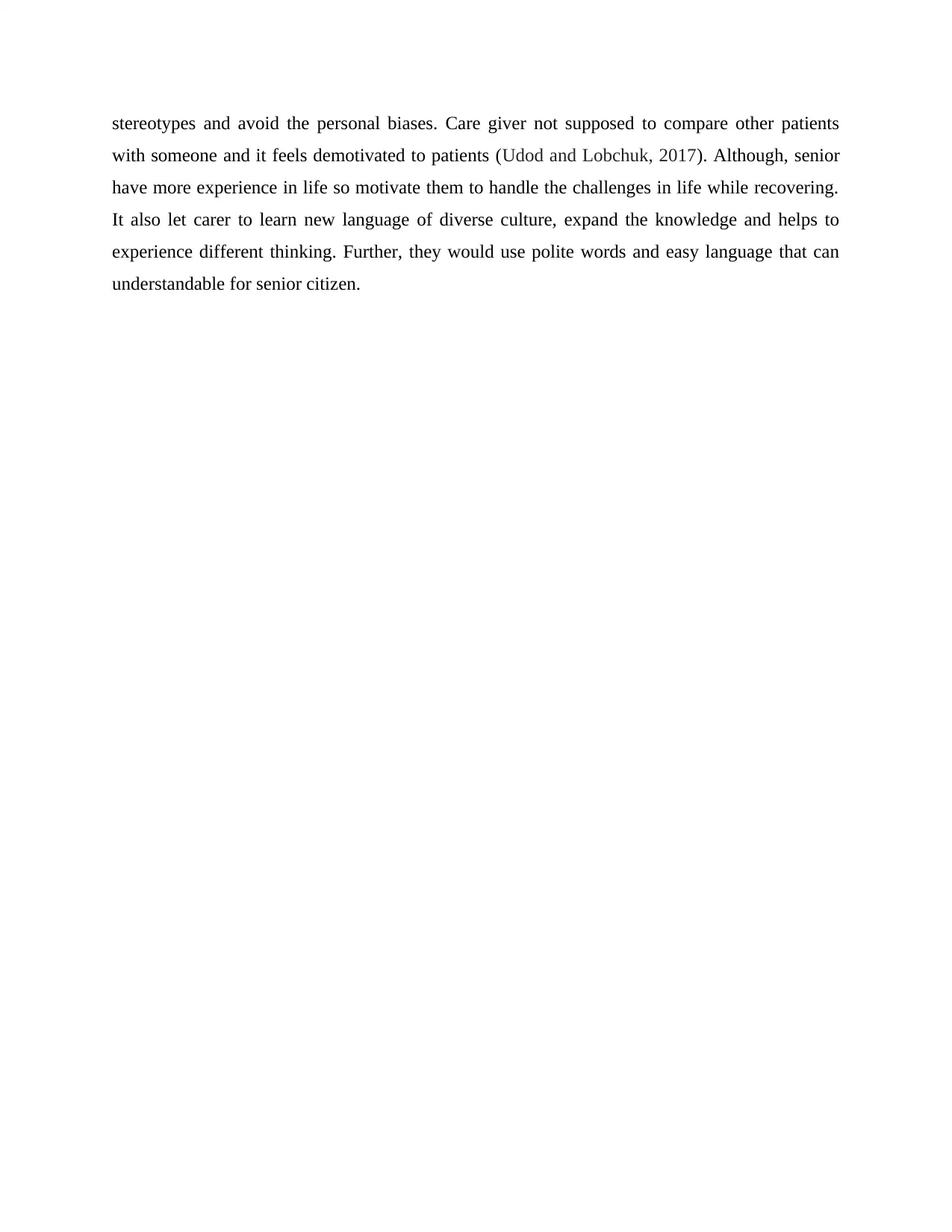
stereotypes and avoid the personal biases. Care giver not supposed to compare other patients
with someone and it feels demotivated to patients (Udod and Lobchuk, 2017). Although, senior
have more experience in life so motivate them to handle the challenges in life while recovering.
It also let carer to learn new language of diverse culture, expand the knowledge and helps to
experience different thinking. Further, they would use polite words and easy language that can
understandable for senior citizen.
with someone and it feels demotivated to patients (Udod and Lobchuk, 2017). Although, senior
have more experience in life so motivate them to handle the challenges in life while recovering.
It also let carer to learn new language of diverse culture, expand the knowledge and helps to
experience different thinking. Further, they would use polite words and easy language that can
understandable for senior citizen.
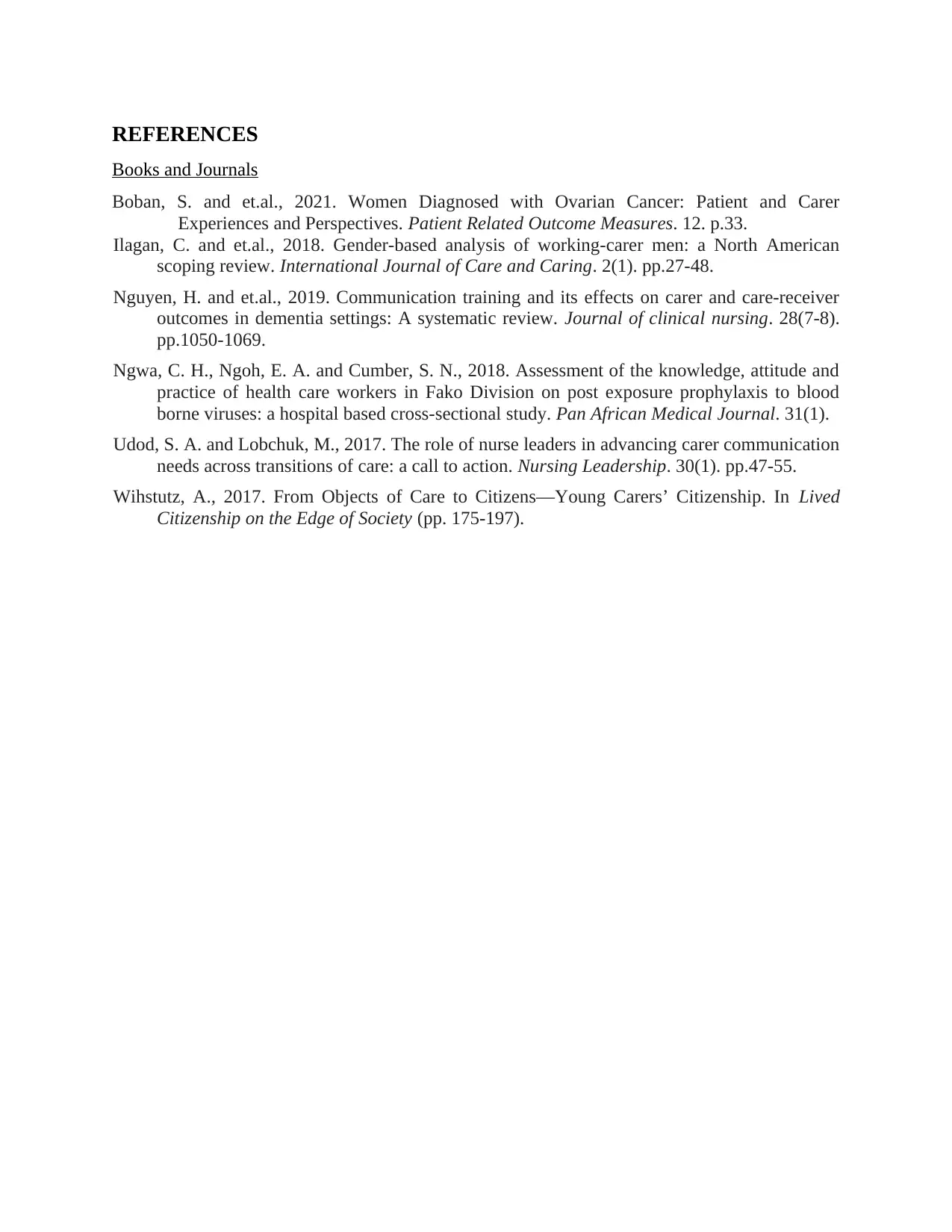
REFERENCES
Books and Journals
Boban, S. and et.al., 2021. Women Diagnosed with Ovarian Cancer: Patient and Carer
Experiences and Perspectives. Patient Related Outcome Measures. 12. p.33.
Ilagan, C. and et.al., 2018. Gender-based analysis of working-carer men: a North American
scoping review. International Journal of Care and Caring. 2(1). pp.27-48.
Nguyen, H. and et.al., 2019. Communication training and its effects on carer and care‐receiver
outcomes in dementia settings: A systematic review. Journal of clinical nursing. 28(7-8).
pp.1050-1069.
Ngwa, C. H., Ngoh, E. A. and Cumber, S. N., 2018. Assessment of the knowledge, attitude and
practice of health care workers in Fako Division on post exposure prophylaxis to blood
borne viruses: a hospital based cross-sectional study. Pan African Medical Journal. 31(1).
Udod, S. A. and Lobchuk, M., 2017. The role of nurse leaders in advancing carer communication
needs across transitions of care: a call to action. Nursing Leadership. 30(1). pp.47-55.
Wihstutz, A., 2017. From Objects of Care to Citizens—Young Carers’ Citizenship. In Lived
Citizenship on the Edge of Society (pp. 175-197).
Books and Journals
Boban, S. and et.al., 2021. Women Diagnosed with Ovarian Cancer: Patient and Carer
Experiences and Perspectives. Patient Related Outcome Measures. 12. p.33.
Ilagan, C. and et.al., 2018. Gender-based analysis of working-carer men: a North American
scoping review. International Journal of Care and Caring. 2(1). pp.27-48.
Nguyen, H. and et.al., 2019. Communication training and its effects on carer and care‐receiver
outcomes in dementia settings: A systematic review. Journal of clinical nursing. 28(7-8).
pp.1050-1069.
Ngwa, C. H., Ngoh, E. A. and Cumber, S. N., 2018. Assessment of the knowledge, attitude and
practice of health care workers in Fako Division on post exposure prophylaxis to blood
borne viruses: a hospital based cross-sectional study. Pan African Medical Journal. 31(1).
Udod, S. A. and Lobchuk, M., 2017. The role of nurse leaders in advancing carer communication
needs across transitions of care: a call to action. Nursing Leadership. 30(1). pp.47-55.
Wihstutz, A., 2017. From Objects of Care to Citizens—Young Carers’ Citizenship. In Lived
Citizenship on the Edge of Society (pp. 175-197).
⊘ This is a preview!⊘
Do you want full access?
Subscribe today to unlock all pages.

Trusted by 1+ million students worldwide
1 out of 6
Related Documents
Your All-in-One AI-Powered Toolkit for Academic Success.
+13062052269
info@desklib.com
Available 24*7 on WhatsApp / Email
![[object Object]](/_next/static/media/star-bottom.7253800d.svg)
Unlock your academic potential
Copyright © 2020–2025 A2Z Services. All Rights Reserved. Developed and managed by ZUCOL.





